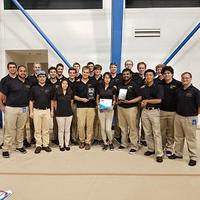Purdue IEEE ROV Team receives Multiple Awards in International Competition
The Purdue University IEEE ROV (Remotely Operated underwater Vehicle) team competed last weekend at the Marine Advanced Technology Education (MATE) Center International ROV Competition in Long Beach, California. The competition challenged students to create a vehicle that could complete underwater missions and successfully defend their design decisions. The missions mimicked real world ROV uses with the theme Port Cities of the Future: Commerce, Entertainment, Health, and Safety. Purdue’s custom designed, built, and tested vehicle, ROV Cephalopod, undertook simulated underwater activities ranging from underwater Hyperloop construction to environmental inspection.
While the competition proved to be exceptionally challenging, the 50-person Purdue team left with two awards plus an individual member award. The Purdue team received first place in the Explorer class for their technical report and product presentation. The technical report was a written document detailing the design and build process that was graded by the judges. The product presentation was received for giving the best presentation to judges as Purdue defended their ROV design decisions and ultimate results. Finally, Katherine Mao, a rising sophomore entering Mechanical Engineering, won the Flying Fish award for her ROV frame design and passion for the field. She was selected out of over 1,000 competitors. Of the 600 competing teams, 25 qualified for the top class in the international competition, and Purdue finished in eighth.
The competing vehicle, ROV Cephalopod, contains a specialized manipulator, custom mission tools, advanced electronics, and newly designed and written software. Through careful planning and consecutive design meetings, the team designed an ROV to execute each mission safely and effectively. Perhaps most impressive is the fact that the team designed and constructed the vehicle from the ground up and in house, from modeling the anodized aluminum frame with CAD tools to writing the software to designing and populating the printed circuit boards (PCBs). While not all designs worked as planned, the team took each issue in stride and was ultimately able to compete with an operational vehicle in Long Beach. Team veterans have passed on their experiences to the newer members throughout the year, fostering growth and a smoother process. ROV Cephalopod is a product of the team’s hard work and dedication.
None of this could have been possible without the support of our sponsors. The Purdue IEEE ROV Team would like to give special thanks to the Purdue Office of the Provost, Solidworks, Boeing, and the Indiana National Space Grant Consortium (INSGC) for their support which makes IEEE ROV an international competitor. We would also especially like to thank former captains Seth Baklor and Michael Hayashi along with team alumni Nick Molo.
For more information contact the captain Kyle Rakos or vice-captain Sanay Shah. Also visit our website at purdueieee.org/rov.
About the Purdue IEEE ROV Team
The Purdue IEEE ROV team is a nine-year-old team of diverse Purdue students whose mission is to foster technical and professional skills of its members by designing, constructing, and testing an innovative underwater vehicle to compete in the MATE Center International ROV Competition. It is a committee within the Purdue IEEE Student Branch.

